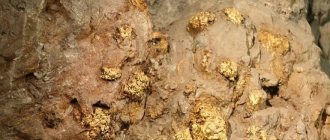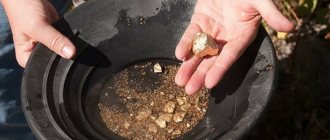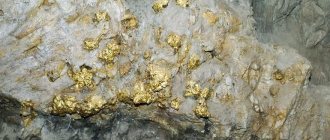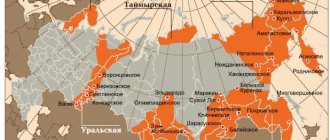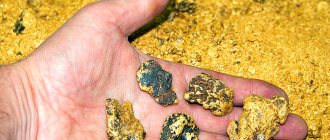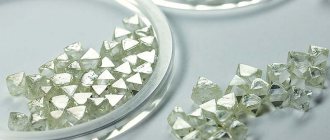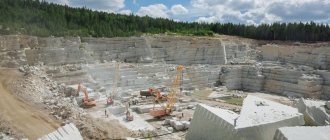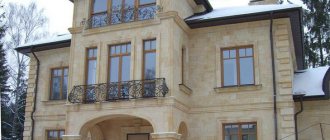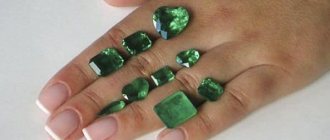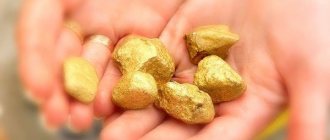P.D. Lunyashin
-
Advisor to the Chairman of the Union of Prospectors of Russia, veteran of the Far North.
Gold mining in Russia is on the rise - over the past 20 years it has doubled, and ore mining (since 1991) - more than 10 times. Since 2010, the number of enterprises engaged in the extraction of precious metal has been steadily growing. If in 2010 there were 395 such enterprises, then in 2022 there are already 571. Dozens of new enterprises are created every year: in 2017 - 72, in 2022 - 82. But dozens of labor collectives also stop gold mining. The majority of enterprises produce less than 500 kg; in 2022 there were 484 of them, with 367 of them producing less than 100 kg per year. And annual production of more than 2 tons per year is carried out only at 27 enterprises.
Over the 300-year history, about 19 thousand tons of gold were mined in Russia, of which over 15 thousand tons came from placers. To date, the recorded gold reserves have been significantly depleted. In the distributed subsoil fund there are 2466 alluvial deposits with the remainder of the approved State Reserves Committee (TKZ) reserves of 450 tons (as of 01/01/2018), in the undistributed fund there are 2907 alluvial deposits with gold reserves of 549 tons (cat. A+B+C1+C2), At the same time, the balance of the approved GKZ and TKZ reserves is only 281 tons. With an annual production of more than 80 tons of gold from placers, in less than 10 years this fund will be exhausted.
The forecast resources of gold in placers (according to TsNIGRI data) are 1450 tons, and only 700 tons of them are by category. P1. At the same time, more than 25 billion m3 of mining waste with estimated resources of 2.5–3 thousand tons of gold, suitable for mining and metal extraction, are concentrated in the Far Eastern region alone. A significant part of this gold is non-industrial, which cannot be assessed using current exploration methods and due to the lack of a legislative definition of man-made formations.
For many years, placer gold mining has been considered a dying industry; in recent years, it accounts for 23% of all-Russian production. But it is the placers that are of particular importance for the Far Eastern region: they provide the bulk of jobs and are a city-forming industry for many villages. About 40 thousand people work at placers. In addition, about 100 thousand people are employed in related industries. In general, 140 thousand jobs is a lot for the sparsely populated northern regions. Of course, this is not much compared to Soviet times, when 300 thousand people were employed at placers, but then 160–170 tons were mined from placers annually.
Today, alluvial deposits are the basis for the work of about 500 small mining enterprises and artisanal artisans. One of the main sources of replenishment of the mineral resource base of these enterprises was the development of man-made formations, the main limiting factor for the widespread development of which is the lack of relevant definitions in the Law “On Subsoil”.
The introduction of the “declarative principle” in 2014 somewhat revived the work on geological exploration of the subsoil; 36 placer gold deposits were put on the state balance (including 20 deposits with reserves of 3.6 tons in 2022). Total for 2014–2018 700 licenses were issued out of 1,940 applications submitted. The results are still modest, but it must be taken into account that licenses were issued only for areas with category P3. Expansion of the “declarative principle” for the Far Eastern region to subsoil areas with cat. P1 and P2 will undoubtedly have a beneficial effect on the development of geological study of the subsoil.
The results of placer gold mining could be much higher, but there are a number of problems, including the following:
- Strict regulation of all procedures related to the search, exploration and production of gold.
- High regulated deadlines for completing the procedure for approving design and other permitting documentation.
- Bureaucratization of the licensing process for certain types of activities.
- Lack of a legislative definition of the concept of “man-made formations” and laws allowing the development of such formations.
- The presence of numerous by-laws that contradict the law.
- Lack of interest of government officials in replenishing SME placers.
- Personnel problems.
On regulation and centralization
Already today, minor deviations from the volumes of gold mining or sand washing planned in annual projects in a number of places lead to the punishment of gold miners.
Currently, the State Duma is considering draft law 6355677 “On amendments to the Law of the Russian Federation “On Subsoil” on the content of a license for the use of subsoil and amendments to it.” According to production workers, changes to clarify the content of the subsoil use license are aimed at strengthening administrative regulation of the industry, primarily, the timing of work and the provision of reporting materials. The new version of Article 12 of the Law of the Russian Federation “On Subsoil”, which determines the content of the license for the use of subsoil, provides for 11 types of different deadlines that the subsoil user must comply with, including in relation to fields that have not yet been discovered. I would like to note that at the stage of obtaining a license for geological study or a license for geological study, exploration and production, there are no well-developed design documents. At this stage, the license agreement is preliminary. Thus, the probability of discovering an industrial deposit based on the results of geological study, search and evaluation of mineral deposits of precious metals does not exceed 10%. The average confirmation of resources of subsoil plots put up for auction does not exceed 10–20%. In the new version of Article 12 of the Law of the Russian Federation “On Subsoil”, the developer unjustifiably considers the terms of the license for the use of subsoil as absolute, which must, of course, be implemented within the established time frame during the geological study and use of the subsoil plot, without taking into account their probabilistic nature.
In fact, the provisions of this article are aimed at strengthening control over the subsoil user’s compliance with the terms of the license, but in practice they can lead to formal mechanical control over the actions of the subsoil user, who will become a violator of the subsoil use conditions contained in the license if he does not meet the deadline or scope of work specified therein. At the same time, prerequisites are created for administrative pressure from supervisory authorities on a specific subsoil user.
In order to reduce excess requirements, the Union of Prospectors of Russia proposes the following:
- Reduce the types of fixed terms and volumes of indicators contained in the subsoil use license.
- Provide that the subsoil user enterprise fulfills the requirement for production volumes for all the enterprise’s licenses for the extraction of a given type of minerals, and not for each individual deposit for which the enterprise has a license. The supply is related to the depletion of placer deposits, which forces subsoil users to purchase a large number of licenses for small placers to create reserves that will allow them to meet the planned production volumes. The fields are located in hard-to-reach areas with delivery times for equipment and materials and the creation of a support base up to 1–2 years. The time frame for completing documentation for the development of placer deposits, taking into account the established requirements, takes up to 3–5 years. Taking this into account, as well as the likelihood of confirming the amount of minerals at a subsoil site, it is quite difficult to fulfill the volume of production specified in the license for a specific deposit.
What was the result of excessive centralization? It has now become clear to many that issues related to the development of small deposits need to be resolved locally. It is completely illogical to resolve issues related to bulk powder with reserves of 5–10 kg in Moscow. But it turned out that the so-called “optimization” led to the destruction of the local branches of Rosnedra, and there were no specialists left in them who could solve such issues. There is a complete analogy here with the destroyed healthcare system in Russia - half of the hospitals were closed, doctors and medical staff fled due to meager salaries, and as a result, medical care became inaccessible to the population.
Applications of gold
Jewelry industry
Due to its unique aesthetic properties, gold has always been used as a material for the manufacture of exquisite jewelry. Over the centuries, the situation has hardly changed. A significant part of this noble metal ends up in the hands of jewelers who create a variety of jewelry.
However, pure metal, due to its softness, is unsuitable for these purposes. Alloys of gold with copper and silver have proven themselves much better; with additives from non-ferrous metals. This mixture of chemical elements makes it possible to obtain raw materials of the required strength and the desired color shade.
It has become common practice to stamp finished jewelry to indicate its fineness—the content of gold (or other precious metal) in the alloy being hallmarked.
Gold
Investment
Due to a number of historical reasons and physical characteristics: durability, resistance to corrosion, gold has become the most important element of the financial market and the largest source of investment. It can be stored almost indefinitely, and the liquidity of this metal remains constant for centuries. This turns this mineral into one of the most convenient options for investments and long-term savings.
State gold and foreign exchange reserves
One of the areas of use of the described precious mineral is the formation of gold and foreign exchange reserves, which represent highly liquid assets, which include gold in the form of coins. It should be noted that these funds are under the control of government authorities.
Coinage
The use of gold as a national (sometimes international) currency has an ancient history. Moreover, in the 19th and early 20th centuries, all world currencies were tied to a single gold standard. And today, many countries around the world mint investment and commemorative coins based on very high-grade gold. Although paper banknotes have long become the main means of circulation.
Technology and industry
The technical use of the mineral is based on the use of a number of its special properties: softness, malleability, ductility; high electrical conductivity, resistance to chemical influences, reflectivity. The areas of application of this noble metal are:
- Transport.
- Chemical industry.
- Energy.
- Instrumentation and electronics.
- Telecommunications.
- Nanotechnology.
- Nuclear physics.
- Production of modern weapons.
- Cosmonautics.
Food production
Cooking boasts an exotic use for gold. It is here that the exquisitely refined tastes of gourmets are activated under the influence of gold leaf decorations that are part of the manufactured products. This mineral is also used as an original food additive for drinks and food. Which becomes a kind of means of attracting very wealthy clients to the most expensive restaurants on the planet.
Dentistry
This branch of medicine uses gold as a material for dental prosthetics. This becomes possible due to the chemical inertness of the noble mineral and its plastic properties.
Pharmacology
In pharmacology, gold is used to treat autoimmune diseases and cancer.
Time frames for completing the procedure for approving design and other permitting documentation
The total standard time for making a decision to approve an application for the provision of a subsoil plot for use for the purpose of geological exploration at the expense of subsoil users’ own (including borrowed) funds is 119 working days, the standard time for procedures for approving project documentation for placer gold deposits is 269 working days days, preparation of documents related to water use - 215 working days. If for ore deposits with mining periods of 8–20 or more years such terms are acceptable, then for placers that are mined from 2–3 months to 2–3 years, such a delay in the registration period is unacceptable.
It would seem that officials were pursuing a good goal by approving the regulatory deadlines for the coordination and approval of documents, but in practice this turned out to be a complete nightmare for gold miners. Many officials directly say that they could not approve the documentation in 30 days, but could easily do it in 3-5 days, but they are afraid of being accused of corruption... Local salaries are not bad, life is good, the work is prestigious, and for these reasons they do not take bribes . As a result of strict regulation, the time frame for starting work on placers has been extended from the previous 5–6 months to 3–5 years! The issue could have been resolved in a post-Stalinist manner quickly and efficiently, by first cutting all the established deadlines in half, but, unfortunately, in our government we mostly have “calls” - they call for improvement of work, they call for “guillotining” unnecessary instructions, but that’s not the case moves.
What is a bedrock deposit?
Primary deposits were formed in the earth's crust due to magmatic processes. In the magma of our planet, in contrast to its crust, the concentration of gold is much higher. For many centuries, as a result of volcanic activity, streams of hot magma burst onto the surface of the Earth. In terms of its content, magma is a melt of a wide variety of compounds. The melting points of these compounds are different, so when the magma cooled, the refractory substances crystallized first. Inside the already frozen mass, the circulation of more fusible elements continued. These processes in the area of magma breakthrough to the surface contributed to the appearance of gold deposits here.
Particles of gold in a primary deposit.
The melt of fusible elements shot out through cracks in the solidified magma, forming veins within which hot solutions of gold-containing salts continued to circulate. When completely cooled, these salts were destroyed, and gold crystallized in its pure form in the resulting veins. During the release and solidification of magma, many chemical reactions took place; the course of this process could differ, as could the final composition of the compounds.
Primary gold deposits could be formed in different ways, but were always accompanied by magmatic processes. This explains the location of the primary deposits: they are always located in the mountains, where the rock was formed as a result of magmatic activity.
Gold in such deposits is very rare in its pure form; most often it contains other metals. The most common alloys are silver and copper. Sometimes there are gold deposits containing platinum and other elements of this group.
Bureaucratization of the licensing process for certain types of activities
Amendments made to Law No. 99 of 05/04/2011 “On licensing of certain types of activities” in the column (Article 3 p.) required, when involving new areas and deposits in the work, to re-issue numerous licenses (for the right to carry out surveying work, for the right to carry out activities , related to the application of VM for the implementation of the activity “Operation of explosion-, fire-hazardous and chemically hazardous production facilities”, etc.) With short periods of development of alluvial deposits in conditions of an extremely depleted raw material base, many enterprises are in a state of constant re-issuance of licenses.
required, when involving new areas and deposits in the work, to re-issue numerous licenses (for the right to carry out surveying work, for the right to carry out activities , related to the application of VM for the implementation of the activity “Operation of explosion-, fire-hazardous and chemically hazardous production facilities”, etc.) With short periods of development of alluvial deposits in conditions of an extremely depleted raw material base, many enterprises are in a state of constant re-issuance of licenses.
Law No. 99FZ introduced a new concept “place of implementation of a separate type of activity subject to licensing (hereinafter referred to as the place of implementation of the licensed type of activity)”, which means an object (room, building, structure, other object, while the legislator did not provide an interpretation of the concept “other object »
), which is intended for the implementation of a licensed type of activity and (or) is used in its implementation, meets licensing requirements, belongs to the license applicant or licensee by right of ownership or other legal basis, has a postal address or other data allowing the identification of the object. The location of the licensed type of activity may coincide with the location of the license applicant or licensee.
Based on the content of this concept, such an object cannot be a city, a region of the Russian Federation, a subject of the Russian Federation or the Russian Federation as a whole. The object is buildings, premises, structures or other objects that fall under the concept of “place of implementation of the licensed type of activity”, owned by the license applicant or licensee by right of ownership or other legal basis.
To resolve this issue and eliminate unnecessary bureaucratic procedures, the Union of Prospectors of Russia proposed adding to Art. 3 (clause of Law No. 99 of 04.05.2011 “On licensing of certain types of activities”, addition and formulate it as follows: “the place of implementation of a certain type of activity subject to licensing (hereinafter referred to as the place of implementation of the licensed type of activity) is an object (premises , building, structure, other object) that is intended for carrying out a licensed type of activity and (or) is used in its implementation, meets licensing requirements, belongs to the license applicant or licensee by right of ownership or other legal basis, has a postal address or other factors allowing to identify the object data.
3 (clause of Law No. 99 of 04.05.2011 “On licensing of certain types of activities”, addition and formulate it as follows: “the place of implementation of a certain type of activity subject to licensing (hereinafter referred to as the place of implementation of the licensed type of activity) is an object (premises , building, structure, other object) that is intended for carrying out a licensed type of activity and (or) is used in its implementation, meets licensing requirements, belongs to the license applicant or licensee by right of ownership or other legal basis, has a postal address or other factors allowing to identify the object data.
In terms of deciphering the concept of “other object”, indicate: “The place of implementation of the licensed type of activity for alluvial enterprises is a geological alluvial ore area, which may be located on the territory of several administrative districts and may coincide with the location of the license applicant or licensee.”
The absence of a decipherment of the concept of “other object” creates the most favorable conditions for corruption of officials, despite the fact that Article 9 of Law No. 99FZ, paragraph 2, directly states: “A legal entity or individual entrepreneur that has received a license has the right to carry out the activities for which the license is granted, throughout the territory of the Russian Federation and in other territories over which the Russian Federation exercises jurisdiction in accordance with the legislation of the Russian Federation and international law, from the day following the day of the decision to grant a license.”
Features of placer deposits
Placer deposits are called secondary, the reason for this is the peculiarities of the process of their formation. Placer gold deposits are formed from primary deposits as a result of ongoing physical and chemical impacts. The action of winds, temperature changes, precipitation, the movement of groundwater, the vital activity of microorganisms and plants over a long period of time gradually leads to the destruction of rock. The collapsing rock releases the gold contained in it: the precious metal begins to descend from the mountains into the valley, where a placer-type deposit is formed.
The main factors for the formation of placers are:
- The action of water - it is precipitation and the influence of groundwater that contributes to the destruction of the mountain range and
- Descent of gold-bearing rock down;
- Chemical properties of gold - the metal does not react with water, therefore remains in its original form without changes;
- Physical properties of gold - due to its density, the metal accumulated in those places from where lighter elements were washed out by water.
Alluvial gold deposits are different: they differ in size, territory and method of formation. Changes in the earth's surface occurred over millions of years; often, instead of a primary deposit, a placer deposit could form, and at a very great distance from the initial point of magma release.
Gold in placers is more accessible; in primary deposits it must be extracted from ore. Features of the location of precious metal particles can be clearly seen in the photo of rock fragments from both types of deposits.
The presence of numerous by-laws that contradict the law
As an example, we can cite the Order of the Government of the Russian Federation dated May 27, 2013 No. 849r “On approval of the List of objects not related to the creation of forest infrastructure for protective forests, operational forests, reserve forests.
If we act according to the letter of the law, then on the basis of this order, almost all placer gold mining in Russia should be stopped.
Most of the mineral deposits from the Urals to the Far East are located on forest lands and mainly within the boundaries of reserve and protective forests of various categories, including in specially protected areas (OSU). Placer deposits, since they are associated with river and stream valleys, are usually located in specially protected areas. The water protection zone for rivers is 200 m, for seas - 500. This is a destructive factor for placers - placers are always confined to watercourses, not only gold, but also silver, platinum, tungsten - everything that is mined in placers. This problem is especially acute for the dredge fleet - dredges operate in river floodplains and bank protection strips along water bodies cannot be avoided.
The Water Code of the Russian Federation, which defines the concepts and scope of water protection zones (protective forests) and bank protection strips (specially protective forest areas - OZU) in Article 65 (clause 15), directly indicates the possibility of developing mineral deposits without restrictions within the boundaries of the subsoil provided to users mining allotments based on the approved technical design.
The Forest Code (Article 17, Article 21, paragraph 1, paragraph 5.1, Article 43, Article 104, 105, 106, 107) also allows geological exploration and mining in protective forests and OZU.
However, Decree of the Government of the Russian Federation No. 849r dated May 27, 2013 “On approval of the List of objects not related to the creation of forest infrastructure for protective forests, operational forests, reserve forests” prohibits the placement of objects for carrying out work on geological exploration of subsoil and for the development of mineral deposits on the territory of the RAM. Thus, the development of deposits itself is actually prohibited. For example: in the Amur region alone, almost 100% of the areas of the forest fund where placer gold mining is carried out fall within the boundaries of water protection zones. In fact, in order to comply with the requirements of the Government of the Russian Federation, it is necessary to stop the mining of gold from placers on forest lands everywhere. This means liquidating enterprises that provide the country with more than 80 tons of precious metal per year, leaving thousands of people unemployed and depriving local budgets of a significant share of tax revenues. In Russia as a whole, the total area occupied by deposits in percentage terms is tenths of a percent of the total area of protective forests.
The Union of Prospectors made a proposal: “Introduce into Government Order No. 849r dated May 27, 2013, “On approval of the List of objects not related to the creation of forest infrastructure for protective forests, operational forests, reserve forests,” an addition in terms of Granting the right to place in protective forests forests located in specially protected natural areas; in water protection zones; performing the functions of protecting natural and other objects: capital construction projects for carrying out work on geological study and development of solid mineral deposits" (now this opportunity is provided to companies engaged in hydrocarbon raw materials!)
.
Unfortunately, the gold miners did not have such a strong lobby that would solve the problem, as the oil and gas workers did, and the issue remained unresolved, continuing to create powerful incentives to fuel corruption.
Declarative principle for issuing production licenses: pros and cons
The popularity of placer gold mining is understandable: low cost and high degree of extraction of useful components are important.
“Losses amount to 6-7%, while part of the lost gold is returned to circulation as technogenic deposits. At the same time, during ore mining, losses reach 17-25%, and when processing complex deposits - 60-70%,” notes Viktor Tarakovsky.
Now, due to rising gold prices, subsoil users have become noticeably more active. The driver was the introduction of the “declarative principle” of issuing licenses, and today there is almost a carpet covering of all areas where gold mining once took place.
“In general, this is a positive trend. The subsoil user takes out a license on risk terms. The reserves have not been confirmed, and first he invests in prospecting and exploration, and only then in production. This is a huge source of private funds for geological exploration and production,” says Vladimir Makarov, head of the Department of Geology of Deposits and Exploration Methodology, Doctor of Geological and Mineralogical Sciences.
But industry experts Fr. Thus, fly-by-night companies enter the market and receive licenses not for the development of deposits, but for resale. In this regard, Viktor Tarakanovsky proposes not to issue licenses on an application basis to companies that do not have gold mining experience.
And those companies that have already used the declarative principle should be checked, and if they do not have specialists in geological exploration and gold mining on their staff, then their license should be revoked.
It happens that people come into gold mining who really plan to mine gold, but do not have the proper qualifications for this. Often these are businessmen who want to invest money profitably and get it back quickly. The return on funds in alluvial gold mining is indeed very fast, but no one can give guarantees of success here. And the industry itself weeds out such lovers of quick money.
“Many people burn out.” My personal opinion: you can’t be half pregnant. You either work out or you don't. This cannot be treated as a hobby. We need specialists: geologists and miners of a very specific profile. And many construction companies, having equipment, fail because they do not have qualified personnel and experience,” says Vladimir Makarov.
Photo: amur-gold.ru
Lack of interest of government officials in replenishing SME placers
It is interesting that the state has such an interest, but the officials representing it do not. The state receives huge amounts of money from the sale of licenses. Examples of 2022: in the Amur region per stream. Comb winner with a starting payment of 90 thousand rubles. paid almost 200 million rubles, exceeding the starting price by 2218 times! This, of course, is a peak figure, but numerous cases have been recorded when starting payments are exceeded by 50–100 times. At some auctions, winners have already shelled out more than 1 billion rubles for small placers! Funding for prospecting work at alluvial deposits stopped a long time ago. It turns out that the interests of the state and government officials in resolving this issue radically diverge. Under Soviet rule, huge amounts of money were invested in geological exploration, and the country became one of the world leaders. Nowadays we are consistently turning into a third world country, gradually losing the accumulated Soviet legacy.
Gold market
77 countries of the world are showing significant business activity in the global gold market. The sales leaders in the 1st quarter of 2020 were: Switzerland, Canada, USA, Thailand and Australia. However, following the results of the first 8 months of the year, Uzbekistan came out on top as exporters, selling precious metal worth $5.8 billion.
The leading importers recently are: Türkiye, India and China. However, this niche of world trade is characterized by extreme instability and is strongly influenced by the political and economic conditions of the current moment.
Author: Yuri Florinskikh All articles by this author
Latest articles by the author: The largest producers of milk and dairy products in the world Diamonds: properties, mining methods and applications
Source rock[edit]
Diamonds[edit]
Kimberlites are the main source of diamonds. Kimberlites are long "tubes" of lava that rise from the mantle, where diamonds form under high temperatures and pressures. These diamonds are then weathered away from the source and carried by alluvial processes (carried by water) to the source, which become diamond deposits. Alluvial diamond deposits are mined after removing the cap sediment from the top of the rich diamond gravel layer. Approximately 10 percent of diamonds are mined from alluvial diamond deposits. [11] The Witwatersrand Basin in Africa, mentioned above, is a recognized alluvial diamond deposit.
Extraction Methods
As mentioned above, aurum is often fused with other chemical elements in the depths of the earth. Therefore, it must be separated by selecting pure gold. Specialized technology, as well as advances in the chemical industry, have achieved considerable success in this. Moreover, the process of separating particles of “yellow metal” has become almost automated.
Among the main selection methods are known:
- almagalming;
- sodium cyanide leaching;
- flotation.
Despite the complicated name of the first method, if you know the basics of chemistry, you can definitely do the same steps. The essence of almagalming is the use of ordinary mercury. After all, she can attract gold. The course of action takes place in several steps:
- Mercury and rocks are placed in the tank, after which they are shaken.
- Mercury attracts gold and settles at the bottom of a special container.
- The container is heated and the precious metal is separated from the mercury.
This method was quite common due to its practicality and low cost. But today it is not recommended to use it, since mercury has a detrimental effect on the human body.
Leaching with sodium cyanide is an equally popular method. To begin with, the previously mined rock is ground to the smallest particles. Then add sodium cyanide and shake the container well. Unnecessary liquid is released, and solid particles of rock settle to the bottom.
Flotation is not much different from leaching. The rock is also crushed, and then filled with water and oil, after which it is mixed. The liquid remains on the surface, and the metal settles at the bottom.
